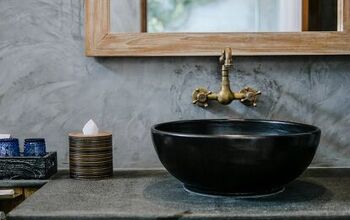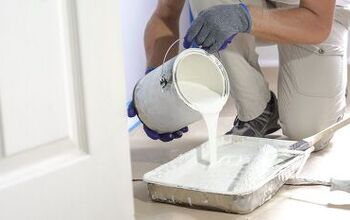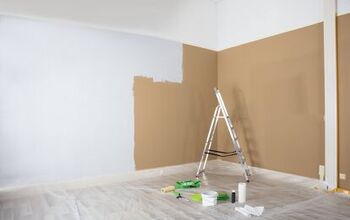Can You Use A Paint Sprayer Indoors? (Find Out Now!)

Large interior spaces may be painted fast and effectively with paint sprayers. The proper kind of paint sprayer must be chosen in order to achieve the greatest results. This is dependent on the size of the area you’re painting and the kind of paint you’re using. But, what about using a paint sprayer indoors?
You can use a paint sprayer indoors as long as you ventilate the area and stay clear of the room for up to 72 hours after. For indoors, you should use an HVLP or airless paint sprayer to control how many paint particles are released into your air.
Spray painting indoors is not a quick load-and-go scenario. There are precautions you will need to take, all of which we include in this article.
How Do You Use A Paint Sprayer Indoors?
Before using your paint sprayer, read the instruction handbook because each one functions differently. To guarantee that you’re operating your particular paint sprayer safely and effectively, consult the instructions.
To properly load your HVLP sprayer with paint, follow the instructions. After that, adjust the HVLP gun to the settings advised for the kind of paint you’re using. Practice your spray pattern and distance on a piece of plywood or drywall before adjusting the settings.
The two typical spraying positions for a spray gun tip are horizontal and vertical. The tip should be set vertically when painting from side to side and horizontally when painting up-and-down patterns.
Don’t be afraid to adjust the settings for an HVLP spray gun’s pressure and spray width in order to achieve the best results for various applications.
1. Prepare the Room
When you use a paint sprayer indoors, a paint mist is produced that stays in the vicinity of you. Eventually, this mist disappears from the atmosphere and covers everything in the space.
Covering up everything in the room that you don’t want to be painted is necessary before interior paint spraying. Cover the floor with drop cloths and tape them to the borders of the walls.
Baseboards, light switches, and outlets should be blocked off. Place plastic bags around ceiling fans and tape them off where they connect to the ceiling.
Windows should be covered with plastic sheeting, with the edges taped. Close up doorways and room openings with tape.
2. Protect Yourself
When painting inside, put on old clothes, comfortable shoes, and gloves. Wear a hat to protect your hair and safety goggles to shield your eyes.
Put on a face mask made of disposable paper that covers your mouth and nose. Open a window in the space and take the screen off before you start painting. Position a box fan in the window so that it draws air from the space and exhausts it outside.
Your interaction with the paint mist is thereby reduced. Use an old fan; otherwise, the paint may have been applied to it by the time you are through.
3. Keep Distance
Maintain the very same distance from the object you’re painting all the time until you’ve practiced and mastered the ideal distance and paint coverage. When painting, keep your movements parallel to the wall and try to keep your arms still.
To prevent streaking, stop moving before letting go of the trigger on the sprayer even before paint starts to cover the wall. To apply paint to the wall evenly, moving at a constant speed is equally crucial.
4. Paint the Ceiling First
The ceiling should typically be painted first, with a horizontal arm motion and a vertical spray pattern.
Before painting the walls, make careful to mask off and cover the painted and dried ceiling. By doing this, you can avoid having to touch up the ceiling later on and guarantee that your lines are straight and tidy.
5. Continue Onto The Walls
It is advised to paint interior walls one at a time, beginning with the ceilings, edges, and ground. Create the wall’s perimeter first. Then, using a vertical arm movement with the tip set to a horizontal spray pattern, fill in the remaining portions of the wall.
Use a cross-hatch pattern for each coat, alternating horizontal and vertical passes, and apply at least two coats of paint per surface for the most excellent results and complete coverage.
Each pass should be spaced between 1/3 and 1/2 the breadth of the spray. The idea is the same as when you overlap your passes when mowing the lawn. Wait about an hour after the room is finished before eliminating any coverings.
How Do You Refill a Spray Paint Gun?
For instructions regarding how to refill the sprayer with paint, how to change the paint nozzle, and how to thin the paint to the right consistency, carefully read the sprayer’s instructions.
Try using the sprayer on some scrap plywood or drywall. The kind of sprayer and the kind of paint affect how far away from the surface it should be. Once you’ve established the ideal separation, keep it throughout the painting.
Apply the paint in even, slick passes that overlap one another. The paint may get lighter on each side and heavier in the middle if you sweep your arm in an arc.
By moving the sprayer before pulling the trigger and withdrawing the trigger before stopping the sprayer’s movement, you can prevent “loading” the paint at the start and end of each pass.
Which Paint Sprayer is Best for Indoor Use?
It’s crucial to manage how many paint particles are released into the air when you use a paint sprayer indoors.
Use a paint gun that sprays paint without carelessly sprinkling it all over the room if you want to spray paint indoors safely and accurately.
High-Volume, Low-Pressure (HVLP) paint sprayers were developed to spray paint fast and uniformly without the considerable overspray that results in droplets and uneven coats on painted surfaces.
The ideal option for interior paint spraying is an HVLP sprayer since it has the necessary power and accuracy to swiftly cover surfaces evenly and smoothly with little effort on your side. This is so that HVLP paint sprayers can use less overspray and apply thinner, more equal applications.
The majority of HVLP applications won’t require you to thin the paint you use, and since the paint canisters and your line are separate, you may store any leftover paint without worrying about having to bother about cleaning the line before and after each usage.
To achieve the best results, some thinning may be required because HVLP guns are less successful at spraying thick coats.
What Are The Different Types of Paint Sprayers?
The task is easier to complete and yields a high-quality finish when using the proper kind of paint sprayer. It’s best to use inexpensive cup sprayers for little projects.
While latex paints often create an even paint finish, they can “sputter” and result in runs. Although they produce more overspray than cup sprayers, air sprayers produce a smooth, even finish.
Faster than other types of paint sprayers, airless sprayers can cover a larger area in a shorter amount of time. They work with most paint varieties without the need to thin the paint.
Less overspray is produced by these types of sprayers, resulting in more paint being applied to the wall as opposed to the air.
For interior work, high-volume, low-pressure sprayers are a suitable option because they generate the least amount of overspray. The primary drawback of these sprayers is that they struggle to apply thick paints like latex.
Airless Paint Sprayer System
The most fantastic time to utilize airless paint sprayers is when you need to cover a lot of surface area quickly and don’t care as much about fine detail.
They quickly apply heavy, thick coats but at the expense of more overspray and bigger droplets. If not handled carefully, they can spread paint unevenly across your walls and quickly fill the air with paint particles.
These guns may frequently utilize thicker paint straight from a can without filtering or decreasing it first since they operate at a significantly higher pressure. The pressure, however, is uncontrollable, therefore they are designed to always spray at maximum force.
For these factors, airless paint sprayers are better employed outside for bigger tasks like siding, decks, and fences rather than for inside paint spraying applications.
Is It Safe to Use a Paint Sprayer Indoors?
If spray paint is used improperly indoors, it could be harmful. Spray paint fumes can irritate the skin, nose, throat, and lungs if they are not adequately ventilated.
Additionally, long-term exposure to these gases might result in nausea, headaches, vomiting, and exhaustion. So, while there are risks, as long as you take the necessary precautions, then using a paint sprayer indoors is usually safe.
How Do You Ventilate a Room for Spray Painting?
Box fans positioned in windows can be used to ventilate the workspace of vapors. Make sure they can’t go flying out the window.
If fans can’t be utilized, make sure there is enough cross-ventilation in the rooms being painted. Notify neighbors in nearby units in advance that painting will start.
How Can I Control Overspray Indoors?
In general, controlling air pressure, using the proper sprayer, and choosing the right nozzle are the most straightforward techniques to stop overspray.
This is because the most frequent reasons for excessive spraying are pressure and spray pattern. If you are working outside, remember to keep an eye out for the wind as well.
How Long are Paint Fumes Harmful?
Even though you can no longer detect the paint fumes, wait at least 72 hours before entering a freshly painted room. To assist in lowering the amount of VOCs in the air, use an air purifier.

Heather is a passionate writer who loves anything DIY. Growing up, she learned everything from home repairs to design, and wants to share her tips with you. When she's not writing, she's usually hiking or searching for her next DIY project.
More by Heather Robbins



























